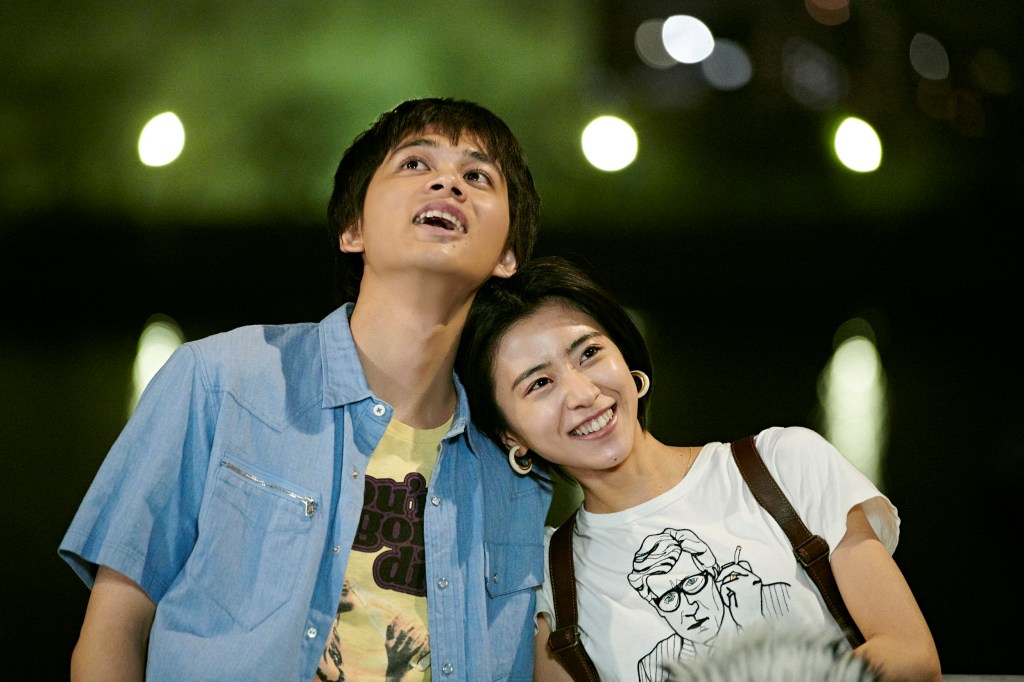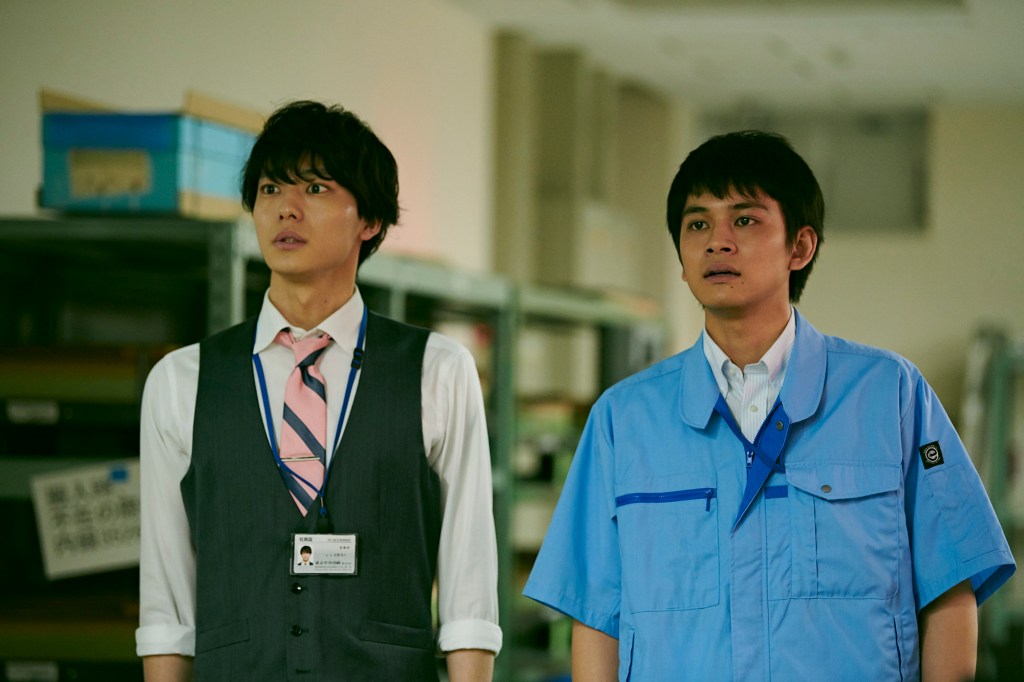Introduction
In 2017, after many years of acting (e.g. Love and Other Cults (2017)), Hana Matsumoto decided to become a director. The first feature film she created was Dadadada Seventeen (2017). Four years later, after directing some dramas for television, she finally presents her second feature film, a film based Masahiko Katsuse’s novel Akegata no Wakamonotachi (2020).
Review
One night, I (Takumi Kitamura) joins a drinking party to celebrate the ‘winners’ of the university, those who secured a job-offer. He will join Tokyo Central Printing next year and silently hopes to play a part in innovating the industry and dazzle his seniors with his novel ideas and creations.
The same night, at the party, his gaze is captured by the elegant features of She (Yuina Kuroshima). By mere chance, he succeeds in initiating a conversation with her. After some meetings, they start dating. Yet, despite seeming happy as a couple, she suddenly disappears.
The End Of Pale Hour explores, by visualizing the trajectory of I from graduate student to working member of society, how a subject and his bodily presence can function as a support for the phantasmatic needs of the other. What Matsumoto’s narrative shows is that subjects do not always need the other as subject, but often utilize this other as a fantasy, as a phantasmatic antidote for their own lingering discontent.
In a certain way, The End Of The Pale Hour highlights the importance of the imaginary dimension for our well-being. Yet, Matsumoto also shows that the mere reliance on the imaginary complicates the ability of the subject to deal with certain social and relational injuries. For I, these injures take on the shape of disillusionments, a romantic and a work-related one.
Matsumoto foreshadows I’s romantic disillusionment by evoking how the relationship between him and She never escapes the imaginary stage. Of course, the first stage of romance is nothing more than a game of imaginary capture. It all starts with the imprisonment of one’s desire by the other’s image. When I first lays eyes on She – a moment emphasised by Matsumoto by using slow-motion, he immediately becomes mesmerized by her elegant image. In other words, what chains his romantic desire to her as image is his sudden perception of the amalgatic object. For him, her bodily presence exudes an imaginary shine that implies that she possesses what he lacks.
The second stage of romance is all about imaginary bonding, the birth of an inter-connection between ego’s (e.g. the discussion about the band Radwimps, sharing their hopes and desires, She‘s quizzing I about Chinese words for certain dishes, the meeting of laughter, … etc.). This stage is also about seducing the other with signifiers and little intimate acts to playfully invite this other to utilize the signifier or the act to symbolically inaugurate the romantic relationship. Yet, such mutual inauguration does not actually take place between I and She (Narra-note 1).
Even though a certain form of romance is established between them – as highlighted by a pleasant musical montage, this romance is solely structured around the search for imaginary relational pleasure (e.g. going on a trip together, … etc.). Their mutual attraction, as function of the image, invites them both to utilize the other as a device to generate pleasure within their interactions and fuel their ego with a sense of contentment.
The second disillusionment takes place when I starts working at the company (General-note 1). The very first day, he is confronted with the ambitions of certain others, like Naoto Koga (Yuki Inoue), at work and experiences a certain difficulty to express himself in front of his more spontaneous and confident colleagues. One could say that he, as part of the social fabric of the company, immediately feels the contrast between the dreams he has and the cold-hard boring corporate reality. One could even argue that the hollow corporate reality he encounters puts the dreams he had and the passion to chase them radically into question.
This contrast is even made more sensible for him when he is, in spite of his wishes, assigned to the General Affairs department. He is introduced to a room full of computer screens and blue uniforms who have almost no interactions with each other – an impersonal space where each member, in a near absentminded state, continues to hit the keys of their keyboard in a vein attempt to finish the never-ending excel files or carries on with a repetitive menial task in a robotic a-subjective state. Moreover, in order to make a chance on promotion, he needs to abide by certain silly rules (i.e. Tilt your seal to the left when you stamp it.) that have no relation to the quality of work he delivers (Narra-note 2, narra-note 3).
The acts that I and his friend, (the equally disillusioned) Naoto Koga start performing after joining the corporate life (drinking, singing at karaoke, batting at a batting centre, … etc.) are, in this sense, answers to this disillusionment, acts to escape, for a fleeting moments, the negative impact of the corporate structure on their subject and reanimate their bodies and frustrated dreams with the sedative called enjoyment (Narra-note 4). Luckily, the presence of She, a presence enabling I to gain relational pleasure within his life, prevents him from succumbing to the assault of his corporate reality on his subject – If you weren’t there, it’d be like I was dead, too.
And then, an unexpected plot-twist in the narrative puts the trajectory of I and She’s romance in a completely different light. This twist, which concerns She’s secret that I knew from the start, does not only invites us to revaluate I’s position within the relationship but also offers the spectator a glance at She’s subjectivity. Yet, can I confront She to resolve the obstacle that stands between them and invite her to vocalize a signifier or perform an act that would give their relationship its first symbolic support? Or will he, confronted with the disappearance of his bodily phantasmatic support and the fleeting instances of relational pleasure, remain emotionally stable? Can he, as time goes by, make peace with her radical absence (Narra-note 5)?
The composition of The End Of The Pale Hour is rich on subtle dynamism – either to frame certain conversations or stage other more ‘static’ moments. This dynamism, sometimes so subtle that is goes unnoticed, is instrumental in heightening the naturalism of the interactions between the characters. More violent shakiness is also thoughtfully applied to visually echo the subjective disarray of certain characters.
Yet, what gives the visuals of Matsumoto’s narrative their atmospheric and naturalistic feel is not so much the subtle shakiness, but the refined natural colour-and lightning design (Cine-note 1). The colours and lighting allows Matsumoto to visualize parts of Tokyo (e.g. the area around Meiji university, Shimokitazawa, Koenji) with a refined naturalism, giving the spectator a genuine feel of streets at night and day-time, the atmosphere within shops, and the manner in which subjects enliven the interiors of food and drink-establishments with imaginary chitter-chatter, food, alcohol, and cigarettes.
Of course, the evocation of a variety of atmospheres within Tokyo would not have been so engaging were it not for the exquisite sound-design. In fact, the natural colour-design merely constructs the atmospheric frame and the sounds, by breathing life into this frame, allow the spectator to bathe in the atmosphere. Moments that have a subjective significance (e.g. I laying eyes on her), heart-warming romantic interactions, or instances marked by more equivocal emotions are elegantly accentuated by the mellow musical accompaniment and, in some rare cases, also by a decorative instance of slow-motion.
With The End of The Pale Hour Matsumoto delivers an amazing narrative. With her refined sense of naturalism, she does not only allow the spectator to grasp the importance of the imaginary and relational pleasure within romance for the subject, but also realize that such pleasure, by being symbolically empty, offers little protection against the oppressing demands of the society and imaginary injuries dealt by others. Highly recommended.
Notes
Narra-note 1: Some spectators will notice that She never tells I that she loves him. This absence functions as a premonitory signal. Moreover, neither I or She makes any attempt to invite the other to live together.
Narra-note 2: As is revealed, the specific way one needs to stamp one’s Hanko is merely to show respect to one’s seniors.
General-note 1: The play I and She attend evokes the conflict many young subjects, like I, within Japanese society are confronted with. The societal demands and post-war work ethics – the image of sameness they are forced to clothe themselves with, the strict obedience to corporate rules, the need to suspend their subjectivity in the occupational game, the strict repetition of mundanity that slowly hollows out the subject subjects who life as if they were dead – are detrimental to the hopes and desires the subject has.
Narra-note 3: Luckily, I gets some support at his work from his senior Nakayama (Takashi Yamanaka) and colleague Kiritani (Haori Takahashi).
Narra-note 4: Sex, in this sense,serves both motives. It is not only used to gain some relational pleasure, but also to inject enjoyment into one’s body and ease the burden the subject carries with him.
Narra-note 5: The spectator will realize, as the narrative slowly unfolds, that I is a rather passive subject. He always ends up subjected himself to the inevitability of his situation. He remains, radically, enable to formulate an answer to his misfortune and lacks the drive to try to change his situation.
Cine-note 1: The use of depth of field within the composition heightens the visual pleasure.






I’ve finally watched it and was mesmerised by the lights, the atmosphere, the camera angles…as you said, it feels so real, thanks to the acting from the trio too. I think a lot of people can relate, not in the details and similar circumstances but with the deep core of it, when disillusionment destroys your expectations to the point of (almost) no return. In the end, “I” manages to cope with his adult and work life somehow but romantically can’t get over it. Sad and bitter end…